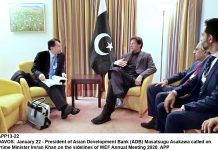
It’s unfathomable to think of a country looking to others for its needs while sitting on a pot of gold. Pakistan has $6 Trillion worth of mineral assets according to the last Geological Survey of Pakistan. For perspective, the entire global mining and minerals industry is worth an estimated $2.12 trillion.
Years of faulty policies and practices have not only reduced Pakistan to the limits of a begging bowl, but also denied the country and its people their true potential.
Trade Development Authority of Pakistan’s report states Pakistan had mineral reserves covering a vast outcrop area of 600,000 square Kilometer. It has 92 identified minerals. Pakistan has the world’s 2nd largest salt deposits, 5th largest copper reserves, and 2nd largest coal deposits, as well as billions of barrels of crude oil; but when will we take real advantage of all this?
The mineral sector’s contribution to GDP is alarming – it stands at a mere 3%. Pakistan’s mineral exports are only about 0.1 % of the world’s total exports, indicating how great a possibility awaits the sector.
One example is Thar, which contributes 10% of Pakistan’s total energy generation, cutting imports by $1 billion annually. Imagine what the sector can lead to collectively. If industry is relocated there and cheap electricity, without distribution losses is provided, it can solve the industry’s demand of regionally competitive energy prices by increasing competitiveness and can possibly result in additional exports worth $20 billion.
The international stage is replete with examples of countries that have harnessed their mineral resources for economic prosperity. Chile has become the world’s leading producer of copper, contributing around 28% of global copper output. Chile’s success is attributed mainly to its mining-friendly policies, stable regulatory environment, and investments in basic infrastructure. Pakistan can easily become the 2nd largest producer by realizing its true copper potential.
Australia is by far the world’s largest producer of iron ore, and ranks highly for coal and gold production. Its mining sector’s contribution to the country’s GDP is estimated to be well over 10%. Punjab’s Chiniot region has 250 million to 1 Billion tons of iron ore deposits and 15MT-60MT of copper reserves valued at a minimum of $8 Billion. Phase 1 of mining will last for about 40 years. Investment required to set up the mining and steel processing mill is $1.27 Billion. Punjab should be open to investors and should welcome investment in setting up the mining operation and HRC steel plant. Once the plant is established, it will serve 80% of the local demand through import substitution and leave 20% capacity for export.
We can also learn and benefit from China who has gained an inimitable mastery of extracting and processing rare earth minerals. With these minerals having become indispensable in the production of electronics, microchips, renewable energy technologies, and advanced weaponry, China looks set to dominate global mining and trade.
So what then is holding us back?
The case of Punjab
Apart from its fertile land, Punjab has an abundance of minerals, including considerable deposits of coal, chalk, bauxite, kaolinite (china clay), fire clay, silica sand, marble, iron ore, placer gold and salt.
During my tenure as the provincial minister, we uncovered 32.6 metric tonnes of gold deposits in River Indus, particularly in the Attock district, verified by the Geological Survey of Pakistan (GSP).
But I noticed two major impediments to extracting gains from these highly valuable natural resources. Intention and strategy. I observed that there was a serious lack of general intent and will to develop this crucial sector. The other was our failure to incorporate modern machinery, techniques and technology into the mining industry.
While the world has moved on to relying on collaborative partnerships and technology to explore and extract minerals, our industry remains focused on traditional mining practices.
Successive governments have failed to introduce regulations and legislation to make the sector open to the private sector stakeholders, or invest in technology itself to create a value-adding supply chain for our mined products. Then there were also serious issues concerning, tendering, recoveries, productivity, and safety and welfare of mine workers, all of which combined undermine potential output.
These are some of the reasons Pakistan is a no show among global mining giants despite being one of the most naturally diverse regions in the world.
However, change and success is not that elusive if we only get the first part right: the intent.
As the minister, I realigned the ministry’s focus from barely existing to making Punjab’s mineral offerings globally competitive. We began by shifting to E-tendering to make the auction system transparent and to break the regional monopolies of mining contractors. This led to a collection of PKR 2.17 Billion over and above the target – a 19% improvement revenue collection. We also focused on corruption and recoveries, and took up pending recoveries of close to PKR 3.1 billion as well as initiation of PKR 650 million reference against former officials.
The ministry also succeeded in geographical indication of Salt Range rock salt as pink rock salt that will limit the unauthorised use of Pink Rock Salt by other countries. Designation of 27 new areas of Rock Salt mineral, approval of 36 new sand zones, and exploration of placer gold deposits worth Rs 800 Billion and end to its illegal excavation were simple steps that improved the ministry’s overall productivity considerably. The ministry also achieved a PKR 400 Million profit in PUNJMIN, turning it into a profitable entity after years of inefficiencies.
These efforts made the Ministry of Mines and Minerals the only department not just meeting but exceeding its targeted revenue.
Several initiatives focused on the welfare of workers as well, bringing in reforms that halved the emergency response time from 8 minutes to 4 minutes, led to a 20% reduction in accident fatalities, doubled the marriage grant for workers’ daughters to PKR 400,000, and increased compensation grant in case of death by 33%. We also approved a PKR 1 billion budget allocation for the welfare of mine workers. These steps not only boosted the workers’ morale, but also their commitment to delivering.
The outcomes suggested that with the right intent, focus and a holistic strategy, Pakistan can still achieve much even with the dilapidated infrastructure and traditional methodologies. There is no technology yet that can replace a workforce that does not have the intent to perform.
Pakistan, today, is at a crossroad, but there is no better time to get our act together and put the country on the road to progress. Our immense potential in the mines and minerals industry can help Pakistan diversify its economy, generate significant revenue, and do away with its foreign debt burden.








